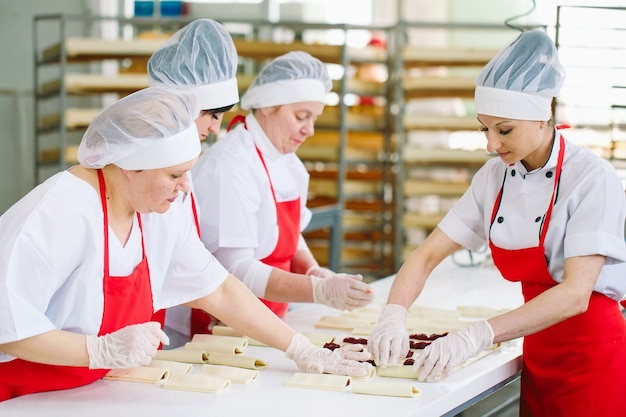Food Processing Uniforms The Ultimate Guide to Food Safety
In food manufacturing, uniforms are essential tools in maintaining hygiene, protecting employees, and ensuring food safety. But what kinds of uniforms are suitable for food processing environments? Employers often turn to HACCP (Hazard Analysis and Critical Control Points) for guidance.
Although HACCP does not stipulate any specific standards regarding uniforms for food manufacturing, its principles can be used to assess and choose the right clothes for employees. This internationally accepted management system identifies and controls the risks to food safety, including those of a biological, chemical, and physical nature. Let's look at how HACCP principles guide the design of food safety uniforms and their key features.
What Is HACCP?
HACCP was initiated in 1995 by the National Advisory Committee on Microbiological Criteria for Foods under the U.S. Department of Agriculture and other agencies like the FDA. It is a preventive process for managing the risks of food safety right through the chain of supply, from the production of raw materials through consumption.
Accordingly, HACCP involves seven principles upon which the scheme is based. These include:
1.Conduct a hazard analysis.
2.Determine critical control points.
3.Establish critical limits.
4.Establish procedures for monitoring.
5.Establish corrective actions.
6.Establish verification procedures.
7.Establish documentation procedure.
HACCP will let food manufacturers prove respect for food safety. This management system is not all about regulations; it provides great insight into how to keep hygiene and prevent contamination, how to organize the best practice in areas like pest control and traceability, and of course, uniforms.

Key Features of HACCP-Compliant Food Processing Uniforms
HACCP-compliant uniforms are crucial tools in maintaining hygiene, safety, and efficiency in food processing environments. These will need to meet rigid standards in order not to violate the protocols of food safety and to protect both employees and the products they handle. Following are the key features of HACCP-compliant food manufacturing uniforms:
1. Durable Fabric
l Uniforms must be able to withstand frequent high-temperature laundering without degrading.
l High-quality, durable materials prevent fibers or threads from shedding, reducing contamination risks.
l Longevity is critical in maintaining compliance over time, minimizing the need for frequent replacements.
2. Antimicrobial Properties
l Fabrics treated with an antimicrobial agent support the prevention of bacterial growth, mold, and fungi.
l This feature is quite crucial in those settings where raw meat, dairy products, or fresh produce are handled due to the greater risk of contamination.
l Antimicrobial uniforms contribute significantly to overall food safety initiatives.
3. Breathability and Comfort
l Workers often endure long shifts in extreme conditions, such as hot, humid kitchens or cold storage areas.
l Breathable fabrics regulate body temperature, reduce perspiration, and promote airflow, ensuring employee comfort.
l Comfortable uniforms enhance productivity and reduce fatigue, supporting long-term operational efficiency.
4. Stain Resistance and Ease of Cleaning
l Food manufacturing uniforms frequently encounter substances like oils, sauces, and raw materials that can stain.
l Stain-resistant fabrics simplify cleaning processes and maintain a professional appearance.
l Quick-drying materials enable faster shift replacements and reduce downtime.
5. Design Features: No Pockets Above the Waist and No Buttons
l Pockets above the waist are not allowed to prevent the possibility of contamination from falling objects into food.Many facilities opt for completely pocket-free designs for added safety.
l Buttons are also avoided due to their potential to trap bacteria or detach and contaminate food. Instead, snap closures or zippers are used.
6. Chemical Resistance
l Employees often work with cleaning agents or other caustic substances in food processing environments.
l Uniforms made with chemical-resistant products would protect working personnel from burns, skin irritations and long-term ailments due to exposure to such chemicals.
l Additional protective items, such as aprons, gloves, and coveralls, may be required depending on specific tasks.
7. Proper Fit
l Should be appropriate uniforms not too sloppy that can affect the food area or machinery thereby causing contamination accidents.
l Tailored fits ensure both safety and comfort, allowing employees to perform their tasks efficiently.

Best Practices for Cleaning and Maintaining Uniforms
Uniforms are only effective when properly maintained. These cleaning practices ensure optimal hygiene:
1. Hygienic Washing
l The uniforms should be washed at high temperatures to ensure the death of the bacteria as well as other forms of pathogens.
l Use separate containers for clean and dirty uniforms to avoid cross-contamination.
2. Preventing Cross-Contamination
l Provide colored uniforms in different zones in order to clearly identify those people who enter prohibited areas.
l Provide additional uniforms to enable workers to quickly change into another when their uniform gets dirty.
3. Outsourcing Cleaning Services
l Professional laundering service assures the same hygienic standards every time.
l A few companies offer uniform rentals that include free pick-up and delivery services eliminating the headache that comes with maintaining uniforms.
Choosing the Right Supplier for Food Manufacturing Uniforms
It is very important to select a reliable supplier since food safety and operational efficiency depend on that. What to look for:
1. Industry Standards
l Ensure suppliers provide HACCP-compliant uniforms made from approved fabrics.
l Uniforms should be durable, antimicrobial, and easy to clean.
2. Reliable Supply Chain
l A reliable supplier translates into regular delivery of uniforms, negating the possibility of operational disruption.
3. Customization Options
l Personalize uniforms with branding, such as logos, to enhance professionalism.
l Adapt designs to meet specific facility needs, such as chemical-resistant aprons or color-coded uniforms.
At Kutesmart, we specialize in custom and wholesale food processing uniforms tailored to meet HACCP standards and your unique needs. Contact us today to learn how our high-quality uniforms can support your food safety goals and elevate your operational efficiency.
Final Say
Food processing uniforms are indispensable for maintaining hygiene, safety, and efficiency in food manufacturing. Guided by HACCP principles, these uniforms protect employees, prevent contamination, and uphold the highest standards of food safety.
Indeed, over time, durable HACCP-compliant uniforms and proper cleaning practices will provide the necessary continuity of operations and engender confidence in customers and regulators alike. Buying the right uniforms and a reliable supplier is an investment in your strategy that will pay off through enhanced food safety, compliance, and professionalism.
Allow this guide to serve as your blueprint for implementing and managing food processing uniforms that meet the demands of your facility and uphold industry standards.

.png)








